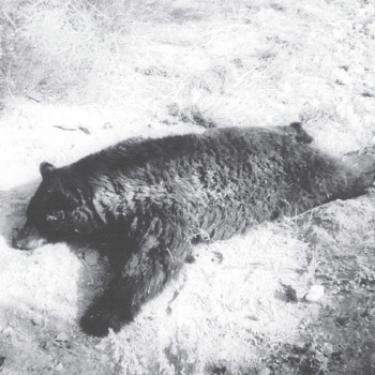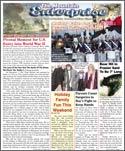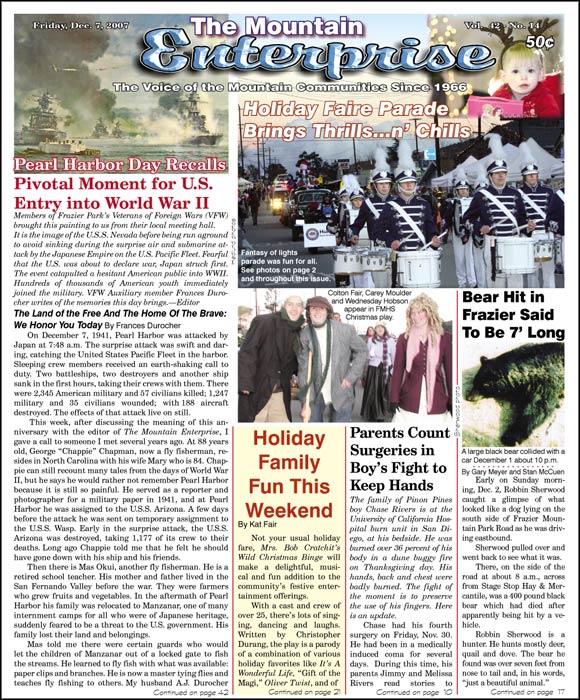
A large black bear collided with a car on Frazier Mountain Park Road December 1 at about 10 p.m.
By Gary Meyer and Stan McCuen
Early on Sunday morning, Dec. 2, Robbin Sherwood caught a glimpse of what looked like a dog lying on the south side of Frazier Mountain Park Road as he was driving eastbound.
Sherwood pulled over and went back to see what it was.
There, on the side of the road at about 8 a.m., across from Stage Stop Hay & Mercantile, was a 400 pound black bear which had died after apparently being hit by a vehicle.
Robbin Sherwood is a hunter. He hunts mostly deer, quail and dove. The bear he found was over seven feet from nose to tail and, in his words, "just a beautiful animal."
"I just thought, ‘what a waste,’ it was such a beautiful animal," he said Monday via telephone from his home on Tejon Ranch, 18 miles eastnortheast of Castac (Tejon) Lake, overlooking Arvin.
Sherwood is as native as Mountain Communities residents come. "I was conceived on Frazier Mountain," he said in a slow drawl. "On top of Frazier Mountain?" I asked, wondering if he was kidding. "Well, I wasn’t there; you’ll have to ask my parents," he quickly responded.
During the two hour wait for Department of Fish & Game to arrive, Sherwood called a couple of hunting buddies, hoping the game warden would allow a hunter with a bear tag to take the animal and make use of its pelt or have it mounted for our local museum, rather than let it go to waste.
He passed the time chatting with Kern County Sheriff’s Deputy Skidmore, who stayed around between other calls needing attention. The hunters estimated the male bear’s age at four to five years, based on the sharpness of the teeth. Black bears live in the wild between 15 and 20 years, according to a National Park Service website.
Sherwood told of a bear that visited his cabin on the ranch seven or eight years ago. The animal got into his ice chest outdoors and sat down with five cans of Budweiser.
"He held the can up sideways and poked one hole in the side with his teeth-then drank the beer," Sherwood said, laughing as he remembered. "Then he went back into the ice chest and got another one!"
He says there is another bear that visits now, but he no longer leaves food or drink around for wildlife to get into.
Stan McCuen, who writes this paper’s Hunt the Mountain column, contacted Doug Updike of the California Department of Fish & Game (DFG) for more information.
Updike said the California bear population is currently estimated to be 30,000 and growing. The annual bear harvest by hunters is set at 1,700 statewide. According to the DFG website the current number of bears taken this year is 1,513. The season ends on the last Sunday in December or when 1,700 is reached.
The harvest count is taken from the number of successful tags returned to the DFG on a daily basis, so this bear will not be deducted from the season’s count. Purchasing a bear tag does not insure a successful hunt, so no refund is available if the harvest maximum is reached early.
California has a long bear season. It runs from as early as August in some areas through the end of December.
Considering the long season and the number of tags sold, the department first set a limit on harvest in 1990.
The original 1,250 limit was raised to 1,500 and then to 1,700 a few years ago due to the increasing population of bears.
The DFG does not control bear population by hunting. That is, it does not try to maintain a constant number of bears. Instead, limited hunting is allowed as long as there is population growth. Should the population begin to decline the limit would be reduced.
Several hunters offered to tag the bear, according to Sherwood, to insure it would not be destroyed. However, road kill is considered an "illegal method of take," and, therefore the DFG has no choice but to dispose of the animal.
The DFG warden told Sherwood that, unfortunately, the animal would have to be taken into the wild and left there to be consumed in the natural process of the food chain.
During the interview, Sherwood said something should be done to allow taxidermists to make positive use of animals which fall victim to man’s presence.
"It’s just such a waste," he repeated, "not to allow a skilled taxidermist like myself or Jerri Johnson to preserve that animal’s body for others to learn from and enjoy. We really need to change this."
By Tuesday morning the mystery about what happened was revealed as California Highway Patrol reports were obtained showing that Rodney L. Janssen, 46 of Frazier Park was driving west on Frazier Mountain Park Road at about 55 miles per hour in a 2005 Subaru Impreza on Saturday, Dec. 1 at about 10 p.m. with a two-year-old child in the car.
He noticed a dark shape suddenly coming across the road from the north. Janssen collided with the animal. Both air bags deployed. He was able to keep the car under control. The bear died on impact the report states. No major injuries were reported to the car’s passengers, but the car itself sustained major damage and was towed from the scene. No citation was issued. This event reminds us all of the extreme care we must take while driving in the mountains, where the unexpected often occurs.
—Additional reporting by Patric Hedlund
This is part of the December 07, 2007 online edition of The Mountain Enterprise.
Have an opinion on this matter? We'd like to hear from you.


